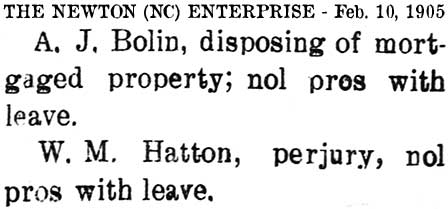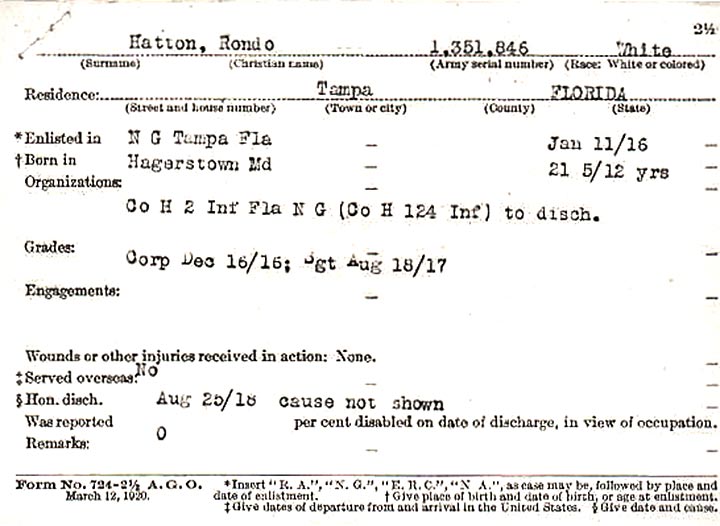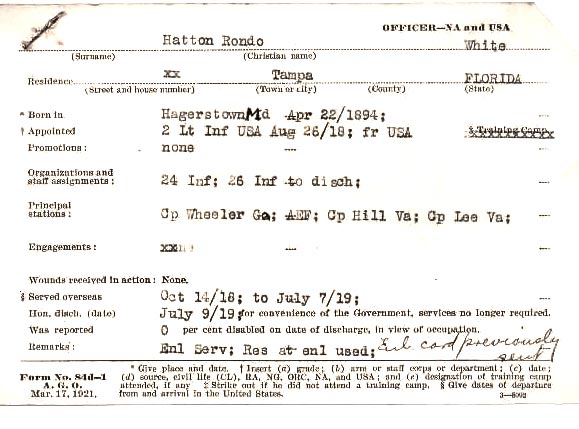| RONDO HATTON - MORE THAN JUST A PRETTY FACE
Photo courtesy of Rex Gordon,
Much of the story which follows is from: "Rondo Hatton: A Biography" by Scott Gallinghouse, with introduction by Rex Gordon, HHS Historian. I have used it as a guide to find source documentation and discover more detail. Many of the personal images of young Rondo Hatton related to his time at Hillsborough High School are courtesy of Rex Gordon, HHS Historian.
THE BRUTE MAN On the screen he was a thug, a bouncer, a convict, a leper, and a psychopathic killer. Off-screen, he was a son of respected educators. He was a shy, devout man who had been an exceptional athlete, an esteemed journalist, and above all, a beloved friend and husband. In the field of film, and in the crucible of a life marred by an inconceivably cruel disease, Rondo Hatton achieved a distinction that survives to this day. That Hatton portrayed his signature role of the Creeper at the tail end of the second Hollywood horror cycle makes his accomplishment, and the cinematic immortality that accompanied that feat, all the more noteworthy.
Rondo Hatton was born into a highly educated college and university founders, professors and administrators. His father, Stewart P. Hatton, was one of six sons of Rev. Wm. Ashley Hatton and his wife Sarilda Ann (Bishop) Hatton, both of Missouri. The Hatton family on the 1880 Census of Jefferson, Scotland Co., Missouri
The Hatton brothers; John H. Hatton, Stewart P. Hatton, Moses W. Hatton, Robert E. Hatton, Linius "Larry" Monroe Hatton, and Bartlett. D. Hatton, were all graduates of the state university at Columbia, Mo. John then revived and headed up the faculty at McGee College, with is brothers assisting as professors.
McGee College was established in 1853 under the charge of the Cumberland Presbyterian church and continued as such until 1883. The Holiness brethren then owned it until 1887 when the Baptist church used it for a year. Then the M. E. church had control of it in 1889 to 1890. In 1891, the Hatton brothers took charge of the school.
In April 1893 he took a business trip to Hagerstown, Md. and returned the the next week. He must have found something he liked there because when he returned home, he married Emily Lee Zaring in Boone Co, Mo. on June 6, 1893. Emma was ten years younger than Stewart and a graduate of the University of Missouri, with a career goal of teaching.
According to a 2008 newspaper article on Rondo Hatton by Julie Greene Stewart and Emily soon moved to Hagerstown, Md. where Stewart and Emily quickly accepted teaching positions at Kee Mar College for women. Stewart was listed as a teacher for the 1893 summer school session, and school catalogs for the mid 1890s included Stewart and Emma among the rosters for 1894 and 1895. Ms. Greene a also cited from Randall's General Directory of Hagerstown, Md. for 1895-1896 listed the Hattons as "teachers who resided at Kee Mar College's dormitory"
It is here in Hagerstown, on April 22, 1894, that Stewart and Emma Hatton's first son Rondo K. Hatton was born. (Film historian Barry Brown once wrote in an article that Rondo was born in the girl's infirmary of the Kee Mar College.) Before Rondo was 2 years old, Stewart had aspirations of being a principal at a college, so the family moved to Hickory, NC where Stewart had negotiated with the trustees of Claremont College for a lease of three years in July 1896, with an option for five years.
Stewart Hatton's brother, Moses W. Hatton, married a former math teacher of Kee Mar College. The article may have incorrectly described Miss Perkins as a former teacher instead of Prof. (S.P.) Hatton.
In April 1899, Rondo's brother, Stewart Price Hatton Jr. was born in Hickory, NC.
Over the years, the other Hatton brothers dispersed from Missouri to establish, teach and preside over various colleges and universities from the Midwest to the east an south U.S. Prof. S.P. Hatton recruited his brother, Moses Wesley Hatton, a postgraduate of Harvard, to teach math and astronomy at Claremont. In the spring of 1900, Stewart traveled to Charleston, W. Va. to start the Powhatan College for Young Women, in the Hotel Powhatan building. His brother, Moses W. Hatton, remained at Claremont to succeed him as president of that college by July 4, 1900, Stewart, along with his family, moved to Charleston, W. Va. sometime in the summer of 1900.
The success of Powhatan College enabled Stewart to move into a brand new $70,000 facility in 1907. S.P. Hatton was a consistent speaker at educational conferences in WV, which usually in included promoting Powhatan's advantages, and other general educational topics. One speech that gained him particular attention was "The What and How in Teaching." [Articles, ads for Powhatan]
1910 CENSUS, HATTONS IN CHARLESTON, WV
In 1911 tragedy struck the Hatton family when Rondo's brother, Stewart Price Hatton Jr. died on Aug. 6 after an operation for appendicitis. He was 12 years old. Rondo was overcome with grief but within a few weeks he enrolled as a freshman at the N. Carolina College of Agriculture and Mechanical Arts (Now NC State Univ.) in Raleigh. His course of study was Civil Engineering. In 1912 Rondo was elected as the class historian for the Class of 1915. The 1912 yearbook includes a class history, and though the author is not named, it is virtually certain it was written by Rondo, since his duties would have included that task. Rondo was a member of the Sigma Nu fraternity and the YMCA. He also had a starting position as center fielder for the school's freshman baseball team. The 1913 yearbook of NC A&M made it clear that Rondo expected to return as a sophomore, but difficulties with his father's tenure at Powhatan forced him to end his position as principal of the embattled institution before the next session. With no contingency plan in place, Stewart and his family uprooted once more and came to Tampa in Sept. 1912 where his brother Linius was the president of Tampa Business College, and a partner in the real estate business with the youngest Hatton brother, Bartlett Hatton. Together they had formed the Hatton Bros. real estate firm in Tampa, located in the American Bank Building. Joining his brothers in the real estate business, Stewart Hatton's financial problems were over, for the time being, Rondo enrolled as a junior at Hillsborough High School and was quickly accepted, making many friends who affectionately nicknamed him "Krum." Later in an HHS Yearbook, they would write about him, "We admire the good judgment of "Krum" in coming to Hillsboro, even if he didn't get here until the last year. The bunch took him in at first sight, for they saw he was of the right kind. He has recently decided to study a little for he has found out that grades are not given away here." [HHS photos, articles from RG] Meanwhile, his father, Stewart Sr. was not doing too well with the real estate business and so joined his brothers Linius and Moses as a professor at the Tampa Business College. In 1920, Stewart also joined Thomas L. Bryan in Atlanta as half-interest owner in his business school which became "Bryan-Hatton Business College of Atlanta. In 1931, L.M. Hatton Jr. joined the Tampa Business College as VP as well as instructor of bookkeeping and accounting. [Articles] Rondo went on to excel at sports, lettering on the HHS football team and track team. His cousins, Linius M. "Larry" Hatton Jr. and "Jay" Hatton also members of the Terriers football team. [High school accomplishments, articles] Rondo went on to attend the University of Florida. [UF accomplishments, athletics]
He joined the National Guard on Jan. 11, 1916 when he was age 21y, 5 mos., as a member of Co. H. 2nd Infantry, Fla. He achieved the rank of Corp. on Dec. 16, 1916 and Sgt. on Aug 18, 1917. When he was honorably discharged on Aug. 25, 1918, he was serving in Co H. 124th Infantry. He did not serve overseas during this time. On Aug. 26, 1918 he re-enlisted and was appointed as a 2nd Lt. with the 24th Infantry, serving under Capt. Wheeler in Georgia, Capt. Hill and Capt. Lee in Virginia. Hampton Dunn's article says he went on to France in WWI under Capt. Sumter L. Lowry [no evidence of this]. His service card shows he served overseas from Oct. 14, 1918 to July 7, 1919. WW1 officially ended Nov. 11, 1918 so Rondo's active wartime service in France would have been for about a month. His card shows he didn't serve in any engagements, and suffered no wounds in action. He received an honorable discharge on July 9, 1919 was reported as 0% disabled in view of his occupation.
Doctors believed he was exposed to a poison gas while fighting in France that which started the process of acromegalic growth of his facial bones and tissues. Rondo was a reporter on both the Tribune and the Daily Times [when?], and was loved by a host of friends. He never refused a panhandler who asked for a handout, and those with whom he worked and knew him best, said he was friendly, kind and charitable past the extent of his means. [Articles written by Rondo] In 1929 he made a chance contact with Hollywood director Henry King, who gave him a part in the Rocky Point filming of Hell Harbor. In the summer of 1937 he was looking for work in Hollywood when he was given another part in a King production, In Old Chicago. He then starred in many horror films and had bit parts in nearly 100 other productions.
[Movies, Leland Hawes article--elevator incident.] Rondo Hatton died at his Beverly Hills home on Feb. 2, 1946. He was 52. Obits of Rondo, Stewart, Linius, Moses.
|
||||||||||||
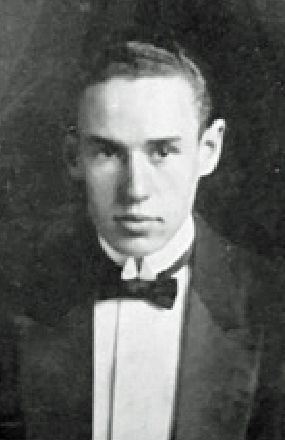 I was diverted into the
subject of Rondo Hatton while working on a sub-feature of
Hillsborough High School a couple of years ago. I was at a
point in the school history where the first business classes taught
there in 1900. The teacher was L. M. Hatton so naturally, I had
to find out what L. M. stood for. He was Linius Monroe Hatton,
Sr. who was also the founder and president of the (2nd) Tampa Business
College. Next was a quest to see if there was a
connection to HHS graduate Rondo Hatton and 1930s Tampa Sheriff L.M.
Hatton.
I was diverted into the
subject of Rondo Hatton while working on a sub-feature of
Hillsborough High School a couple of years ago. I was at a
point in the school history where the first business classes taught
there in 1900. The teacher was L. M. Hatton so naturally, I had
to find out what L. M. stood for. He was Linius Monroe Hatton,
Sr. who was also the founder and president of the (2nd) Tampa Business
College. Next was a quest to see if there was a
connection to HHS graduate Rondo Hatton and 1930s Tampa Sheriff L.M.
Hatton.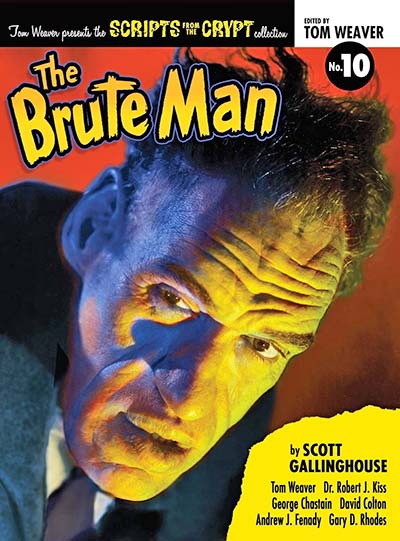

-TIMES-Mcgee-college-now-owned-by-Hatton-bros.jpg)
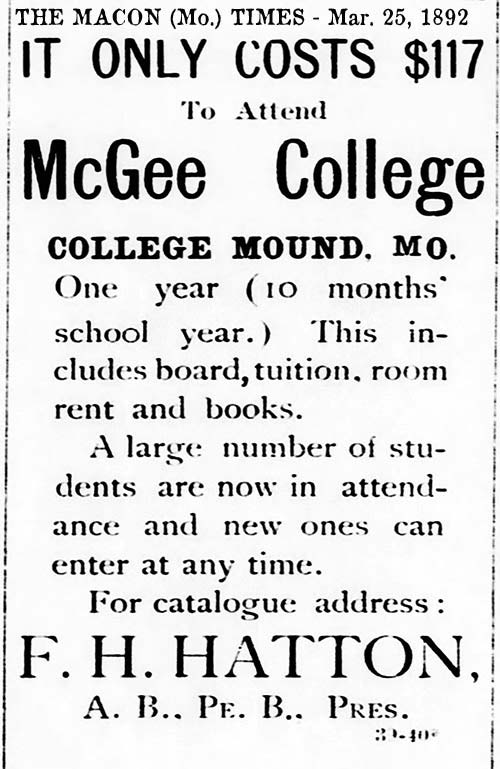
-TIMES-Mcgee-college-to-be-one-of-best-in-state.jpg)
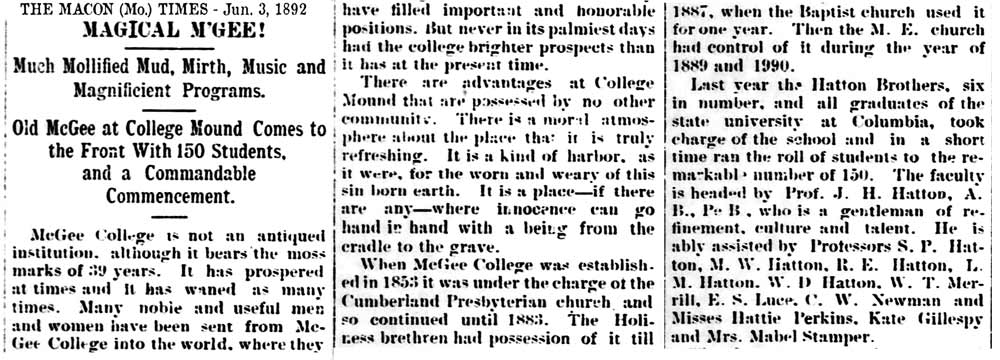
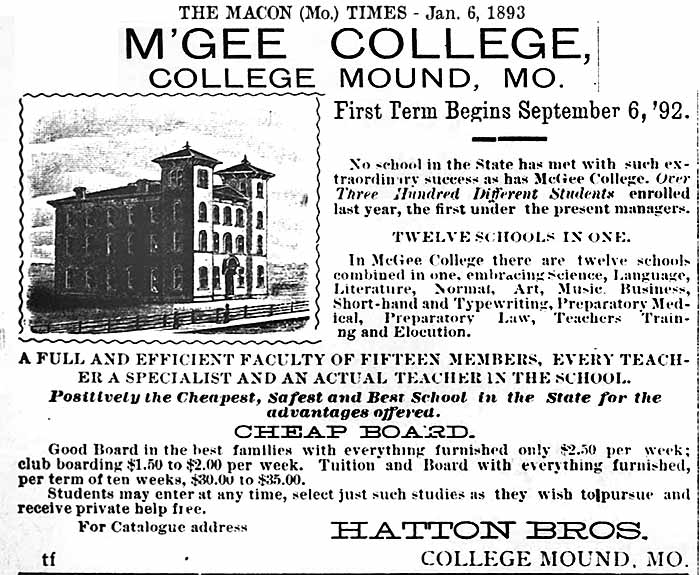
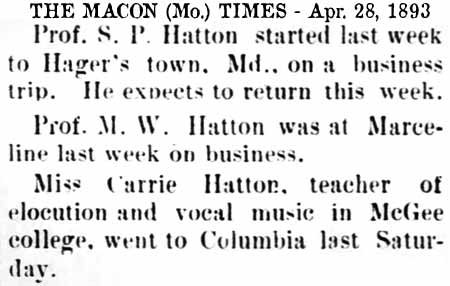
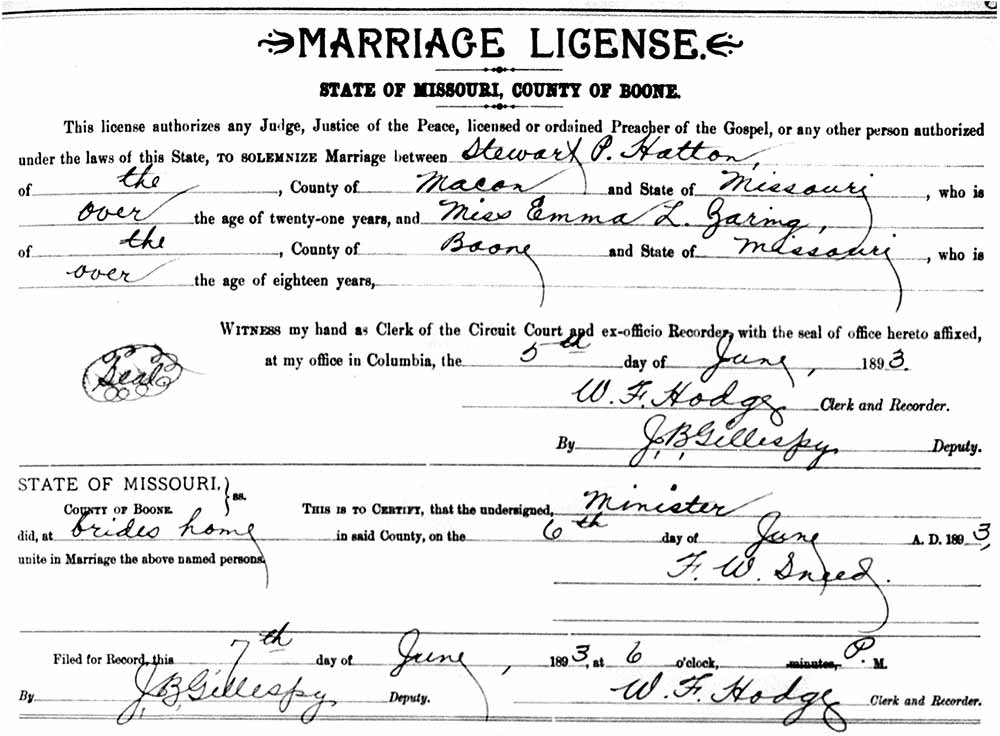
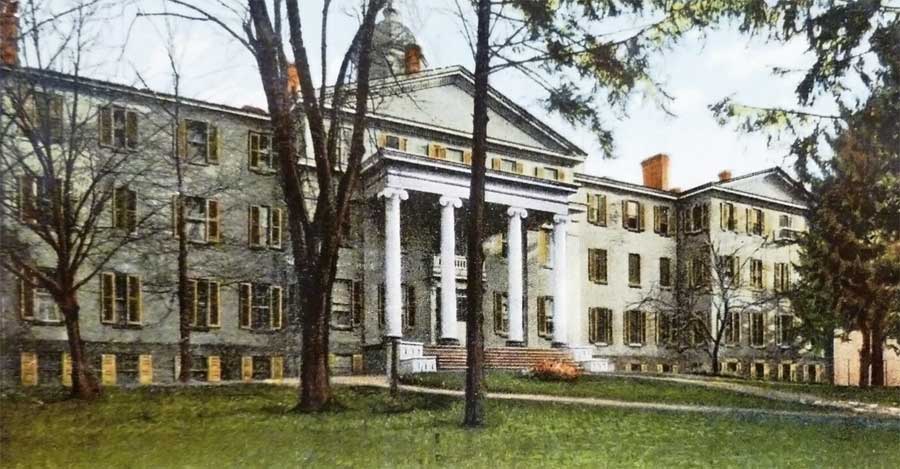
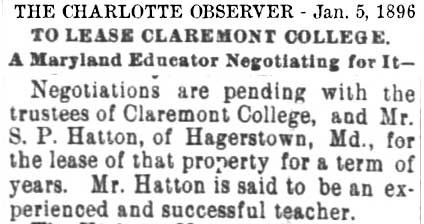
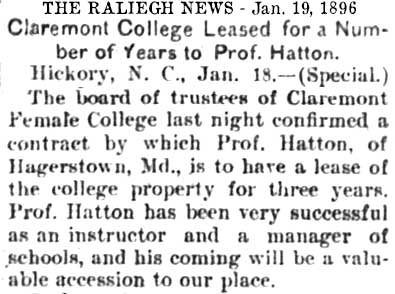
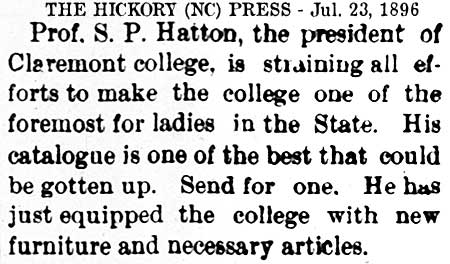 Stewart and Emily improved on Claremont's success and by 1897 there
were around 300 young ladies attending.
Stewart and Emily improved on Claremont's success and by 1897 there
were around 300 young ladies attending. 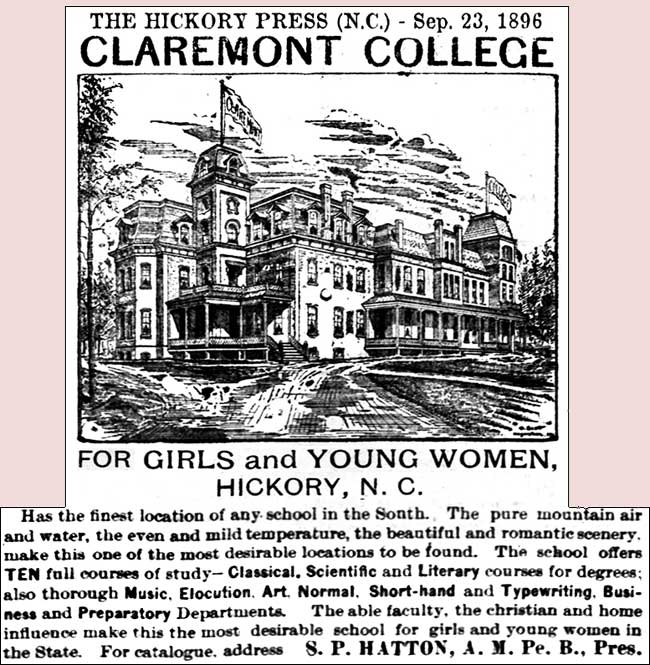
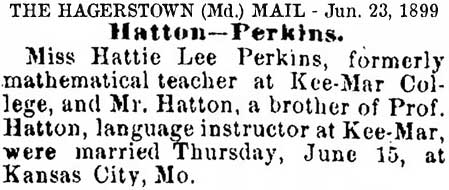


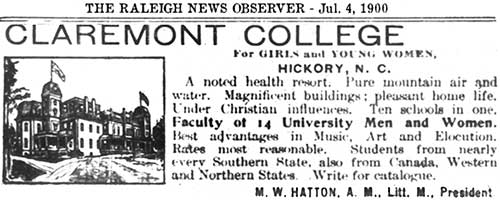
-Hatton-vs-Bolin.jpg)
-What-an-education-costs-MW-Hatton-Claremont-at-Hickory.jpg)
